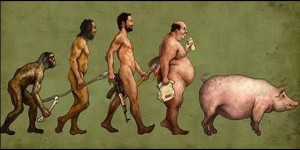This wonderful image comes from IMEO
(Instituto Médico Europeo de la Obesidad) in Madrid, Spain.
http://stopalaobesidad.com/
(1) An evolving singularity (reading Ask the Beasts, pages 236-241)
Physically, like all living creatures, homo sapiens emerged from the material universe. Our life-fluid shares the common molecular structure of water; our eyes respond to the same electro-magnetic waves of light; the rhythms of our days and nights pattern our own behavior, and we share the genetic heritage of every other species.
Intellectually, what propelled the evolution of homo sapiens was a rapid increase in the size and complexity of the brain, accompanied by changes in the position of the larynx which made speech possible. Now a threshold was crossed; cave art from 35,000-15,000 years ago shows that the creative human spirit was already formed, giving our species self-consciousness, language, and fluidity of behavior.
But the human mind cannot be easily reduced to the material function of the brain. Rather, a new complex organization of matter allowed new capacities to emerge. Human consciousness became rich with self-reflective, symbolic, and linguistic abilities:
• With human imagination, we can dissect and reassemble a vocabulary of tangible symbols.
• With language, we can pass ideas from one mind to another.
• With the passage of ideas and inventions from one generation to another, human cultures have taken shape.
• With the development of cultures, humans made an exponential jump in intellectual powers.
Alone among creatures, humans can decipher the very process of evolution.
• Now a species has evolved that can massively effect the evolution of other species, for good or ill.
• Homo sapiens today is a potential agent of evolution – by destroying habitat and changing the environment so rapidly that many other creatures are disappearing in catastrophic numbers.
(2) Human responsibility (Ask the Beasts, pages 241-248)
Since we began using the earth as hunter-gatherers, humans have discovered ever-new ways of interacting with the natural world. In our day the cumulative effect of this activity has reached damaging proportions.
• Population growth: By 1650 AD, the human species had grown to around 1/2 billion members. By the early 1800s this number had doubled to one billion, and then doubled again by the mid-20th century. This dramatic progression puts intense pressure on other species.
• Resource consumption: The earth is now reaching a point of resource exhaustion. Current human use of both nonrenewable and renewable sources cannot be sustained.
• The unequal distribution of resources complicates the picture: around the globe, mistreatment of the environment is intertwined with injustice towards other humans.
• Pollution in many places is exceeding the capacity of natural systems to regenerate.
• Denial does not change the fact that our planet is sick at the structural level, making it unable to provide the resources for all life-forms to flourish. (See Sallie McFague, Blessed Are the Consumers)
(3) Extinction: never again (Ask the Beasts, pages 249-253)
“Death cuts off life; extinction cuts off birth.” (Edmund Wilson)
In Darwin’s theory, extinction plays an essential role in the evolutionary process.
• The historical rate of extinction has been about one species per year. There have also been at least five catastrophic events of mass extinction.
• Recovery from mass extinction is slow: it took 5–10 million years after past mass extinctions for new species to evolve.
• The current rate of extinction is now far above pre-human levels. 150-200 species now become extinct every day; current forecasts anticipate that as many as 1/4 –1/3 of the world’s animals and plants are on a path to extinction within the next 100 years.
• The resulting loss of biodiversity is ecologically dangerous, breaking up the envelope of life that surrounds our planet as a whole. Many scientists now see a sixth mass extinction coming, caused by human beings.
(4) The promise of nature (Ask the Beasts, pages 253-255)
Seen with the eyes of both science and faith, the living world is full of enormous promise:
• The Origin of Species and subsequent biological research describe the progression of life over time.
• Directionality: while there is no clear blueprint, the human capacity for discerning patterns can see in retrospect that there is a sort of directionality to the story of life.
• “From a Christian theological point of view, life and evolution are the universe’s response to the presence and promise of divine persuasive love.” (See John Haught, The Promise of Nature)
In view of the still-unfinished creation of life, we must leave room for future species:
• For all people, religious and non-religious, allowing the embryonic future to perish is a turning away from the promise that lies embedded in all creation.
• For religious people, human treatment of other species may be seen as idolatry, brought about by policies that place lesser good and in particular the gods of money and comfort above the God of life.
(5) Conversion to the earth (Ask the Beasts, pages 255-259)
Human beings need a deep conversion (that is, a turning) to the Earth:
• Spiritually, we must turn from a human-centered view of the world to a wider view that includes other species in the circle of what is considered spiritually meaningful.
• Emotionally, we must turn from the delusion of the separated human self and the isolated human species to affiliation with other beings who share our common status as creatures on this Earth.
• Ethically, we must turn from the view that a moral universe is limited to human beings to understanding that our ecologically destructive actions are degrading the conditions that make life possible for all.
• Socially, we must turn to poor and marginalized human beings, whose health and survival are intertwined with the Earth’s health and survival.
• Ecologically, we must turn to a view of the Earth as an inherently valuable, living community – and we must bend every effort to be creatively faithful to its well-being.

